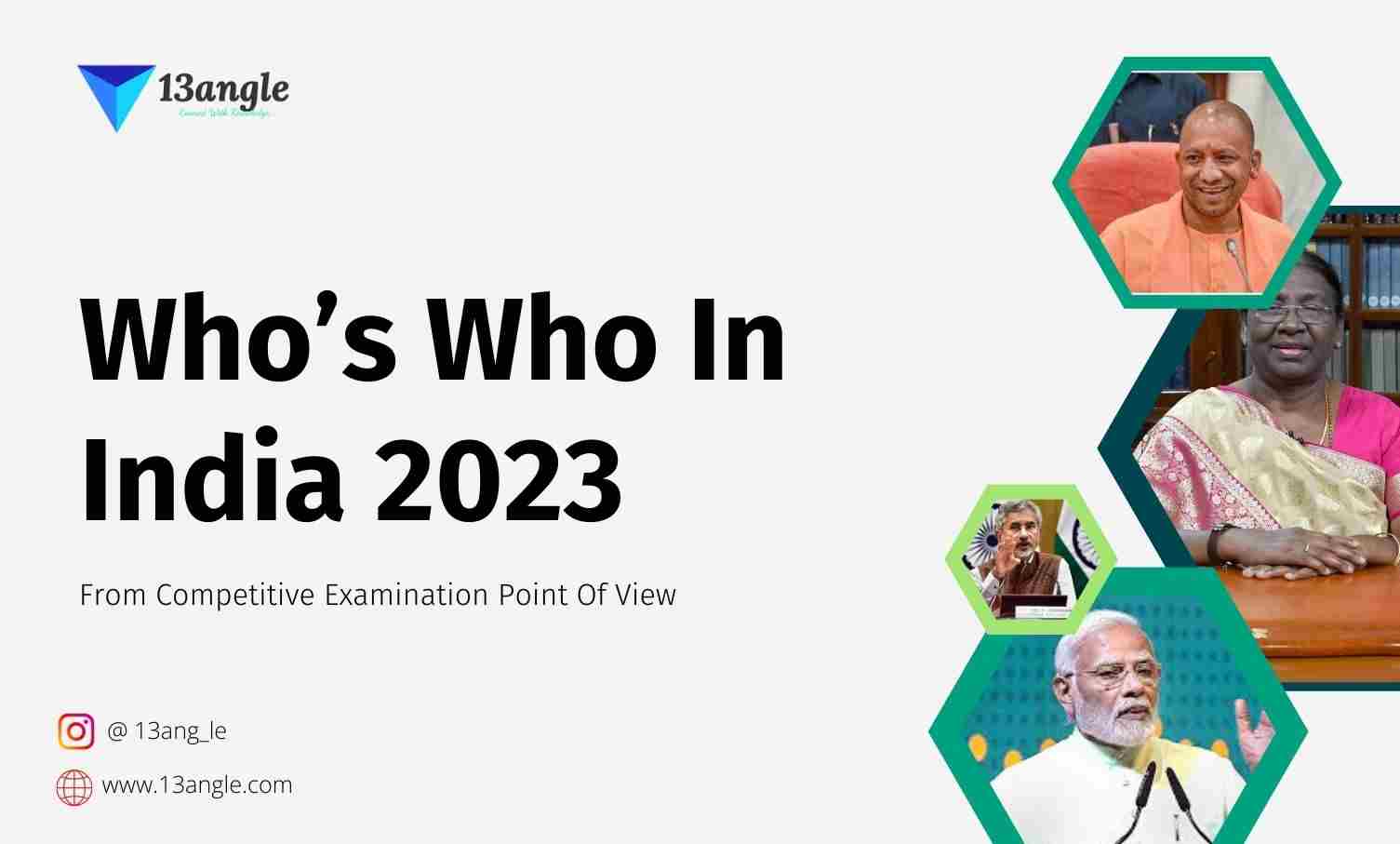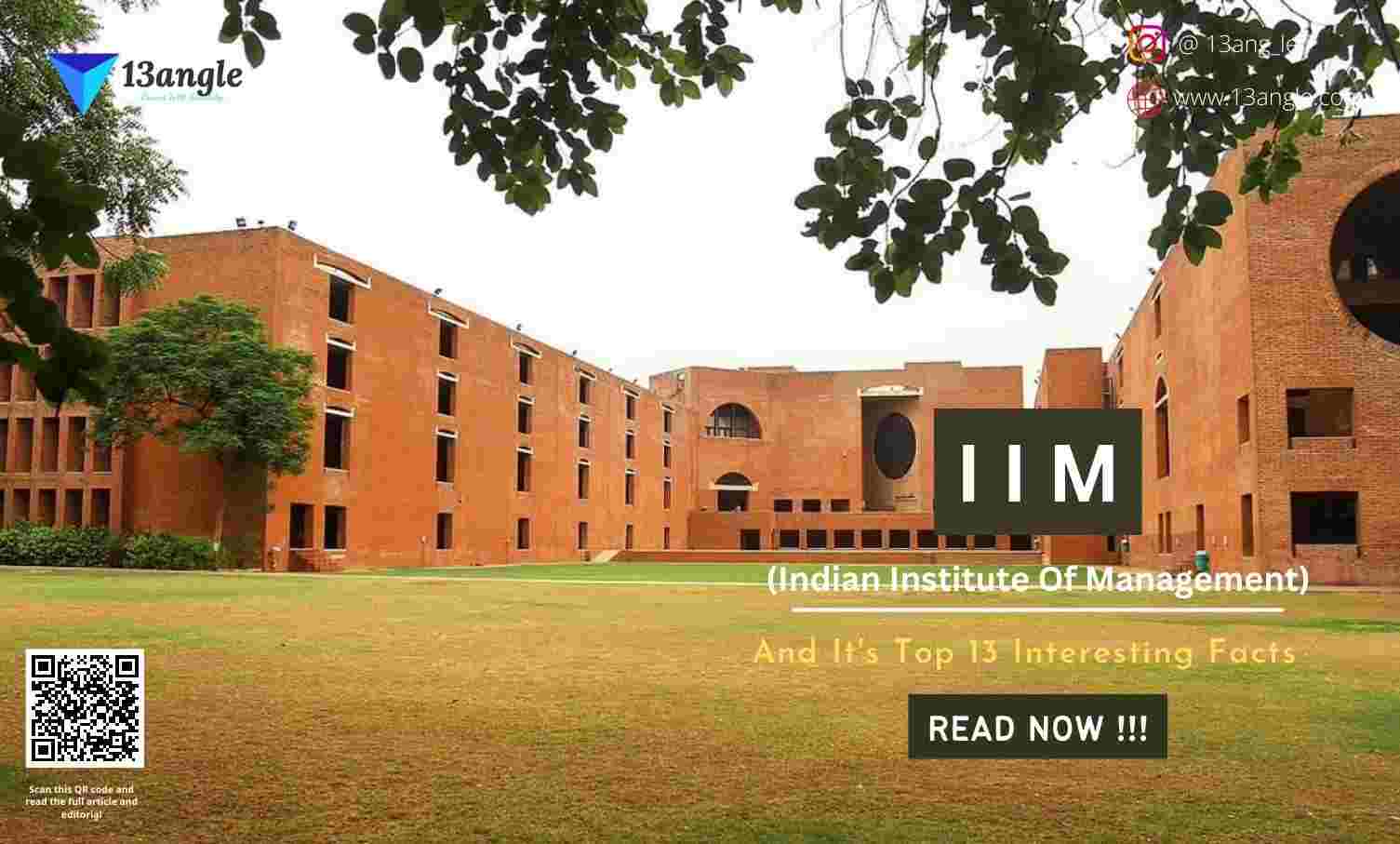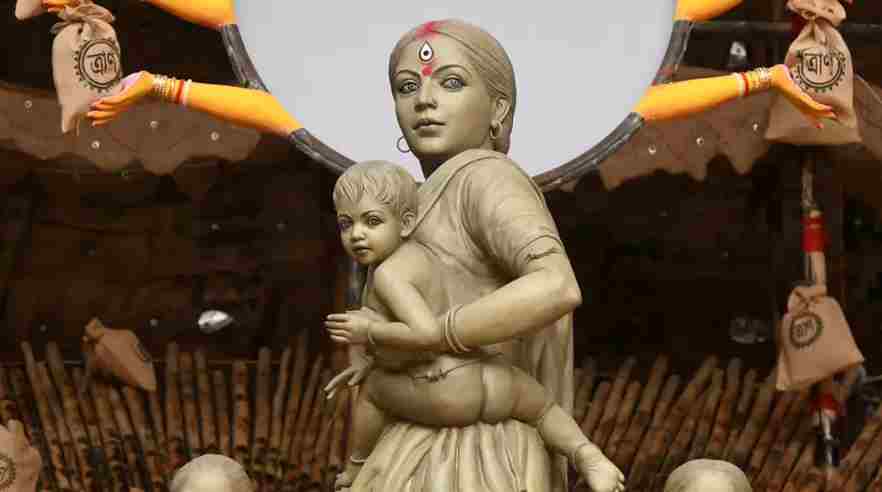
Introduction
- Kolkata has been the host to the Durga Puja, the biggest festival in the region, for over a century. The six-day-long festival starts in the Bengali calendar month of Ashwin. The festival is an occasion for people from all walks of life to come together and celebrate the victory of good over evil, represented by the goddess Durga. During these four days of Durga puja, people use to roam around from pandal to pandal to get a glance at Devi Durga. Roadside food adds a bit of spice to our jubilant Visit. We wear new clothes and do pandal hopping with our family and friends to celebrate puja with joy. The celebration finishes on Vijayadashami when these idols are drenched in water bodies. This yearly celebration of Durga Puja is a festival of commitment, joy, and spirituality among individuals. Here are some of the insights about Durga puja as follows.
Significance Of Panjika
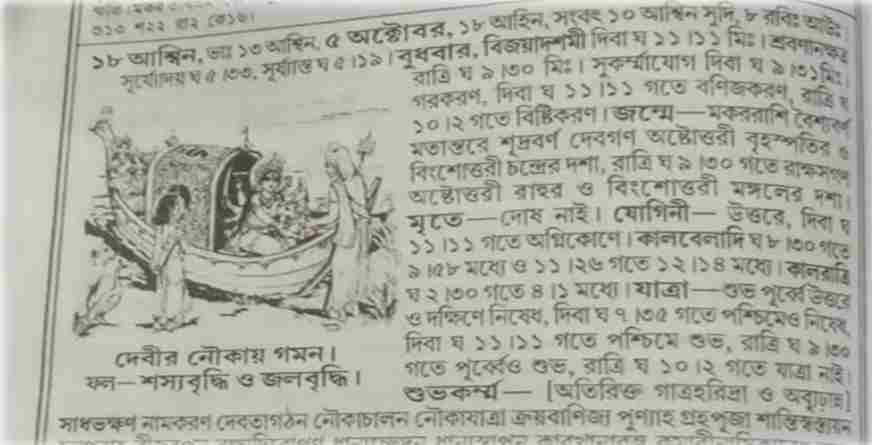
- Bengalis are well connected with their culture and literature they celebrate Durga puja with utmost joy and with full enthusiasm, and to start with the celebration we need to begin with “PANJIKA” it is an auspicious religious book where dates are jotted down, every Bengali home had one of them in their home. Panjika is the most important material required during Durga puja. Panjika enables us to know about each minute detail regarding the puja of Goddess Durga. And let us know about how Devi Durga will travel from Kailash to us by boat, palanquin, elephant, or horse. Every vehicle of Maa Durga has its own importance and effect on mankind. This year Maa Durga is coming on an elephant which means agriculture will be very good this year, and after the celebration Devi Durga is returning by boat which signifies the good benefits of agriculture and the flow of water resources.
Mahalaya
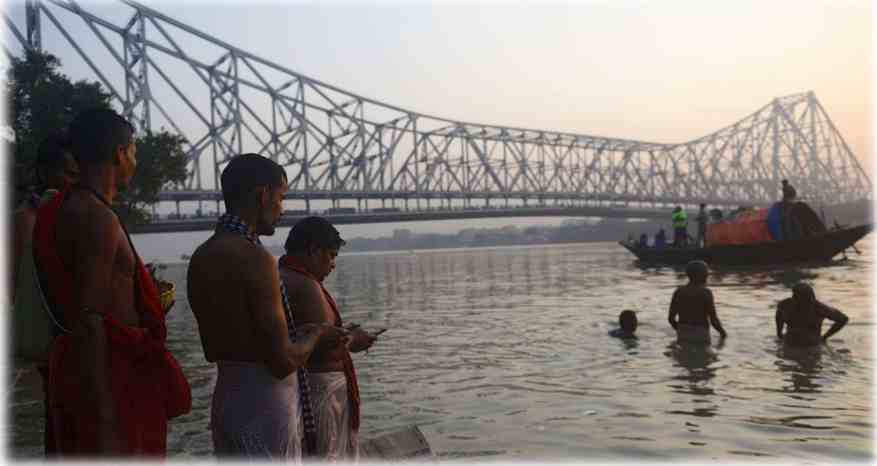
- Mahalaya denotes the invocation of the goddess, and it is observed seven days before the puja, it marks the arrival of the goddess. Prayers are offered on the banks of Ganga with a holy dip and blessings sought from the departed ancestors in the household through the performance of Tarpan on this auspicious day.
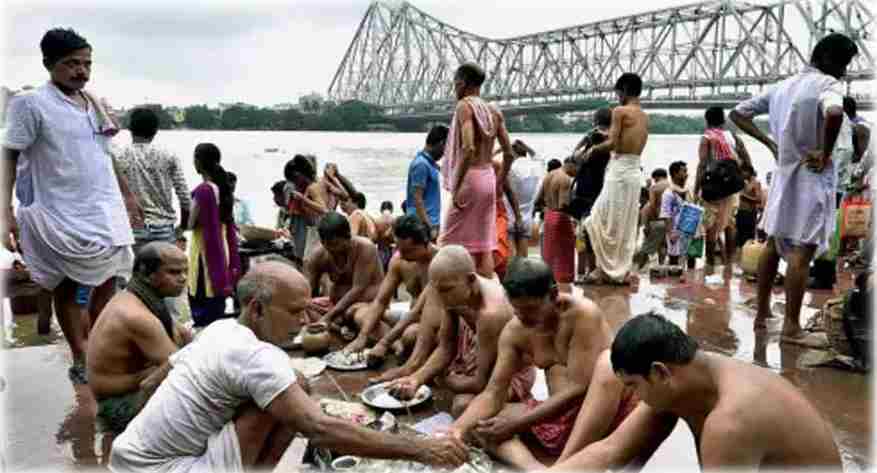
- This day is followed by the end of Amavasya which indicates the beginning of the puja known as Pratipada and marks the end of Pitripakhsha.
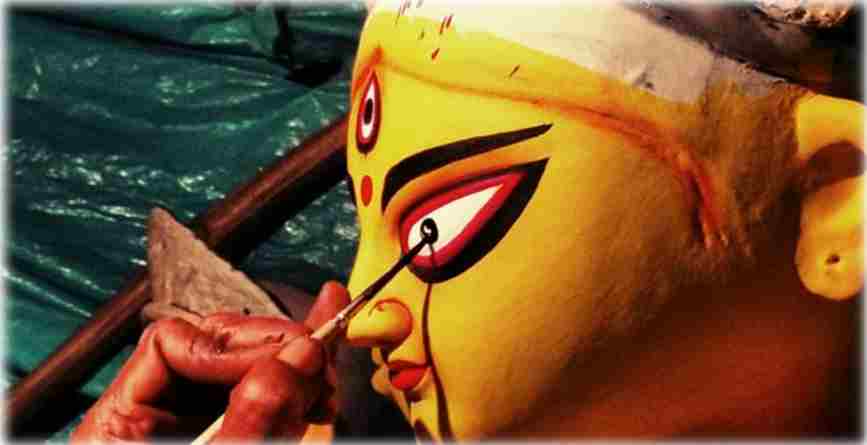
- Chokkhudaan is celebrated at the break of dawn as potters paint the eyes of Durga MAA on Mahalaya. Offering the eye to the goddess, the final stroke of paint should be done in complete darkness using the candle in presence of only one sculptor. Most of the clay is bought by boat down the Hooghly River, obtaining soil from the brothel and mixing it with the rest of the clay, consider Punya Mati from Nishidho Palli.
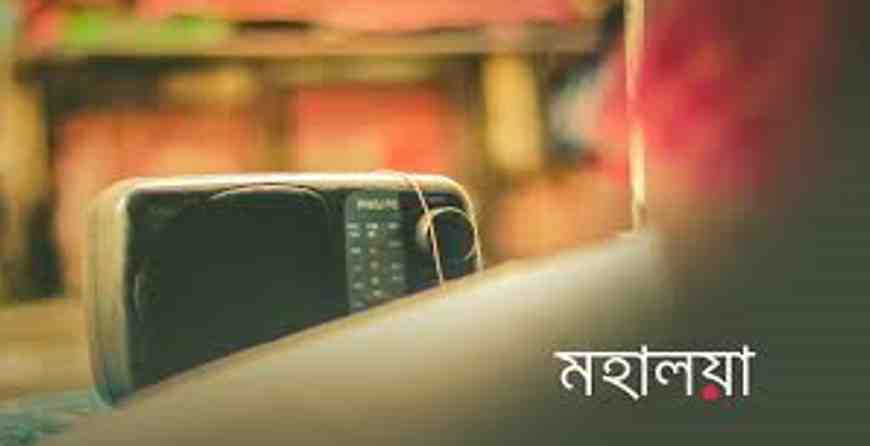
People wake up in the morning listening to Mahisasura Mardini an audio version of Chandipath recitation at 4:00 a.m. all the people residing in west Bengal will tune in to listen to Birendra Krishna Bhadra’s voice in all India radio program, it begins the countdown of Durga puja. Mahisasura Mardini was religiously played in every household in the wee hours of Mahalaya. It is one of the old Indian radio programs played since 1966. Music is composed by Pankaj Mallick.
Khuti Puja
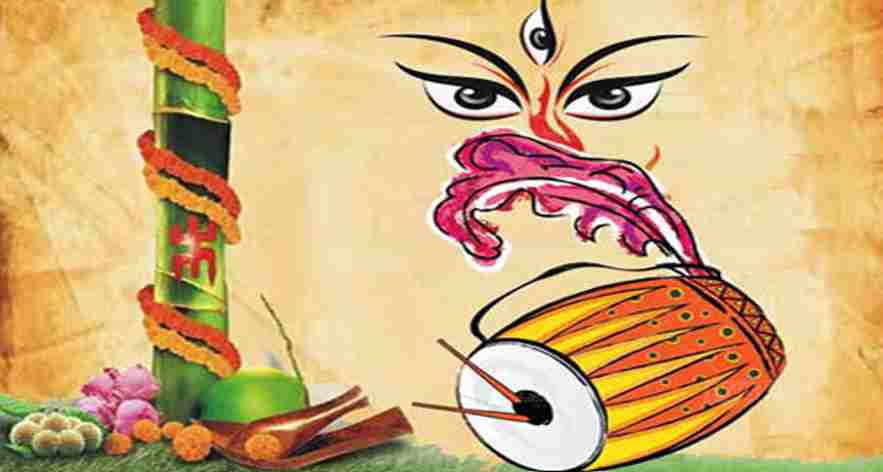
This is a must ritual before the start of the puja. Khuti Puja has now become a norm of sarbojanin pujas.
Khuti Puja is a ritual performed before putting up pandals to initiate the Durga festival. Khuti puja means the worshipping of bamboo pillars that will erect the pandal. To mark the start of Durga puja proceedings every year.
Kathamo Puja
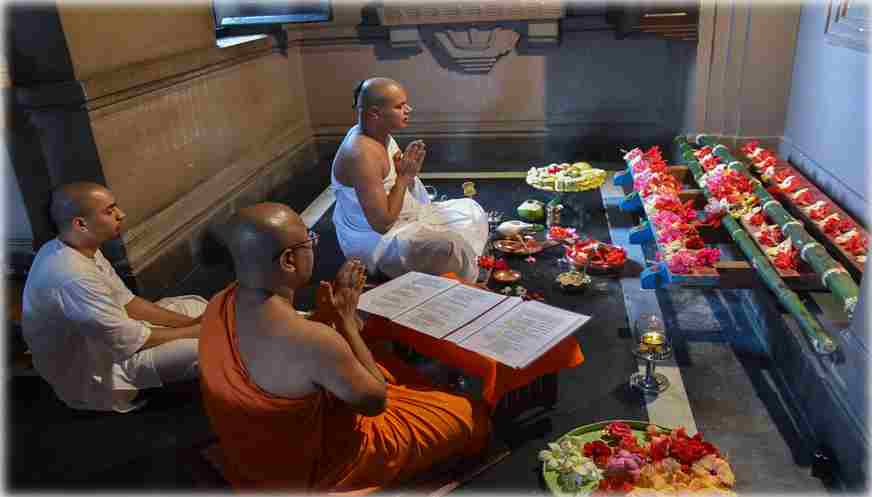
- Traditionally for centuries ‘Kathamo Puja’ or the wooden frames over which the idol is to be placed is cleaned and readied before any ritual of Durga puja, Kathamo Puja is followed till now in “Belur Math”.
History Of Durga Puja
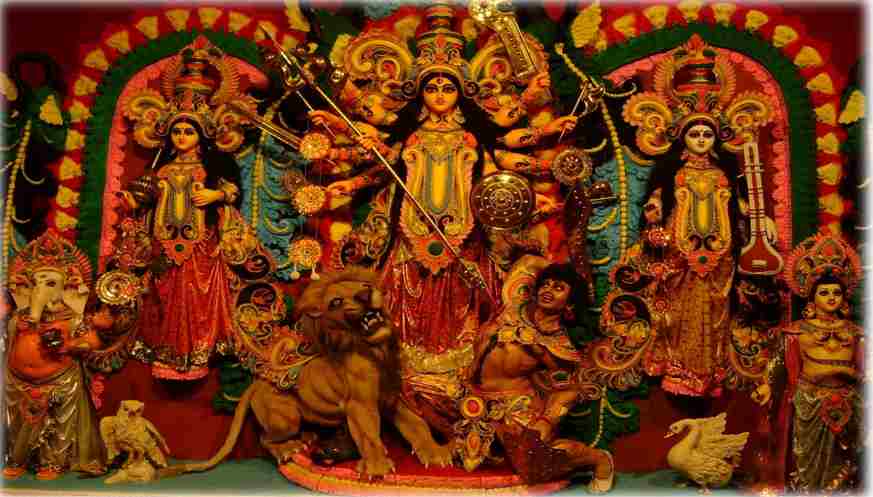
Durga means a fort (durg), which indicates a secured or protected place, also known as Durgatinashini means the one who eliminates suffering. Durga MAA visits her parents, just for a few days a year that is the time when Devi Durga is worshipped in Bengal along with her son Ganesh, Kartik, and daughters Lakshmi and Saraswati. Durga puja in Kolkata began around 1790 it was limited to zamindars. According to the legend, Raja Surath was a powerful king who lost his kingdom and went to lead his life as a wanderer there he met sage Medhas, he suggested him to offer prayers to Devi Durga, and Raja Surath worshipped her every year after this during spring Devi helped him to regain his kingdom, so it came to be known as Basanti puja. Later, Ramachandra himself sculpted a clay image of the goddess and sat down to awaken her through bodhan ritual in the dusk. But even after three days of puja, Devi did not appear. Vibhisana advised Rama to worship Durga with 108 blue lotuses. Devi hid one lotus to test Rama’s sincerity. When that one lotus was nowhere to be found, heartbroken Ramachandra decided to offer one of his eyes to the goddess because people call him the lotus-eyed one. Just as he was about to gauge out his eye, Devi came and stop him, the puja now started from spring to autumn and Bodhan started when Raja Ramchandra offered prayers to Devi Durga in autumn which is a period mainly all the gods sleep this untimely awaken needs a Bodhan. As time flows soon, Raja kangshanarayan changed the time of puja in 1500 CE because earlier during spring smallpox is very prevalent, and not favorable for festivals so it is changed from spring to autumn. In modern times, most pujas begin on Shashti tithi. Most Bengalis are unaware of the original Krishna Navami bodhan and 15 days durgotsav.
Three categories of pujas can be seen in Kolkata predominantly are:
(1) Bone-di Barir Pujo
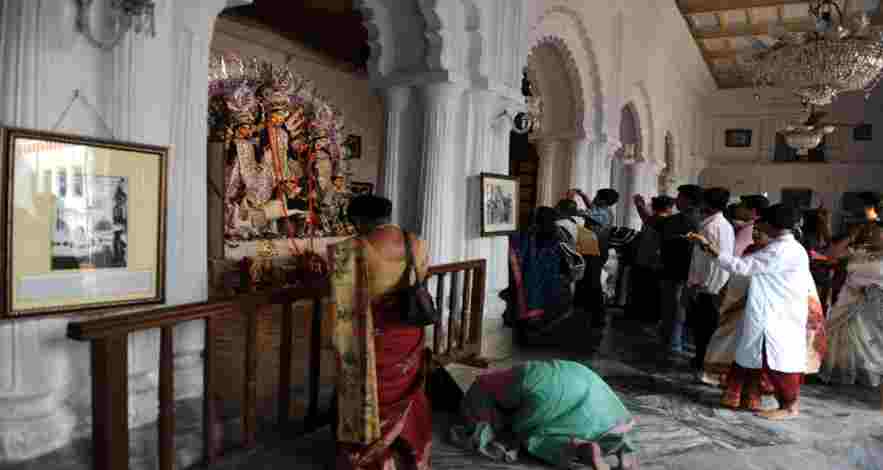
Bone-di Barir Pujo, where only rich people like kings and landowners in Bengal could celebrate due to the presence of wealth, the lower class was not invited. which mainly consists of the rich class or zamindars, others are not allowed to celebrate they are mainly done around the household, and all the members of the family are allowed to enjoy the functions and food.
Gradually Baroyaari puja and sarbojonin puja become frequent in the community. As the left-out families also wanted to enjoy and seek the blessings of MAA Durga. The most important aspect is that the puja is not restricted by caste. The difference between Bone-di puja and Baroyaari is everyone is allowed to enjoy it, and it is mainly seen as organized by housing complexes or a puja committee but not on a large scale, as they have limited resources.
(2) Baroyaari
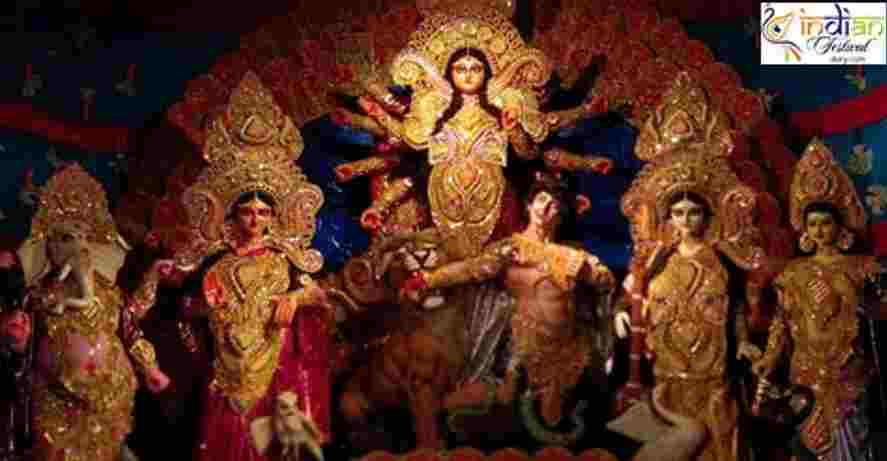
It refers to twelve friends of Guptipara in Hooghly, who collaborated and the collective contribution from residents to conduct the first community puja in 1790. The first organizer of “Baroyaari” Durga Puja in Calcutta was “Sanatan Dharmatsahini Sabha” of Behala, Shakher Bazar. Baroyaari maintains a typical old heritage touch of lighting and Sabeki Idol (traditional idol) with “Daaker saaj”.
Some of the Baroyaari pujas are as follows:-
- Adi Dakhin kalikata barowari samiti
- Atghara Naopara Baroary Durga puja
- Then in Kolkata Baroyaari puja started to change its form and on a large scale with an expensive theme started Sarbojonin Puja which includes theme-based pandals, with expensive lights.
(3) Sarbojonin Puja
Durga Puja is organized by a group of people in a locality, for all the people hence being known as Sarbojonin Durga Puja. Durga Puja, the entire streets of West Bengal are covered by Huge Structures called “Pandal”.
Each Pandal has its own theme based on current affairs, historic events, works of fiction, works of Art, or of any other innovative ideas.
And a various number of clubs are included in it. Sabeki Idol of Devi Durga also changed with time.
In Kolkata the community Durga puja expanded from Baroyaari to sarbojonin. Balaram Basu ghat road started the sarbojonin puja by sanatan dharmotsahini in 1901. Durga puja is no longer a preserve for rich.
- Suruchi Sangha
- Natun dol
- Deshapriyo park
Dhaak
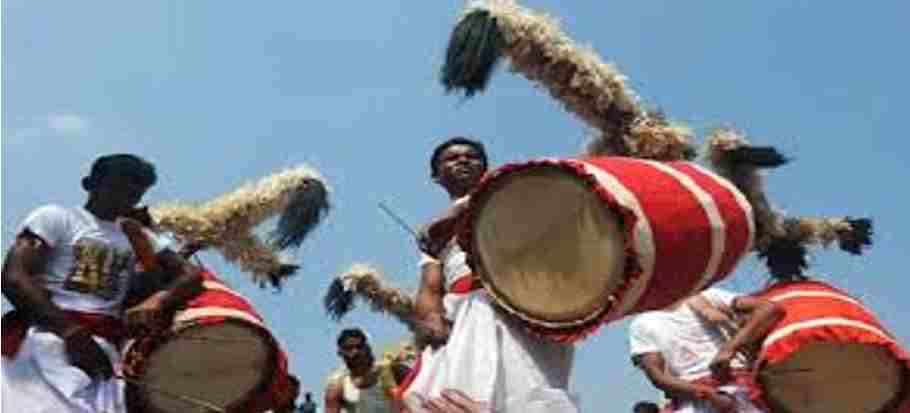
- The instrument is often decorated with white or multi-colored feathers or traditional white flowers known as ‘kaashphool’. Without the enchanting tune of Dhaak Bengalis, Durga puja is incomplete.
Daaker Saaj
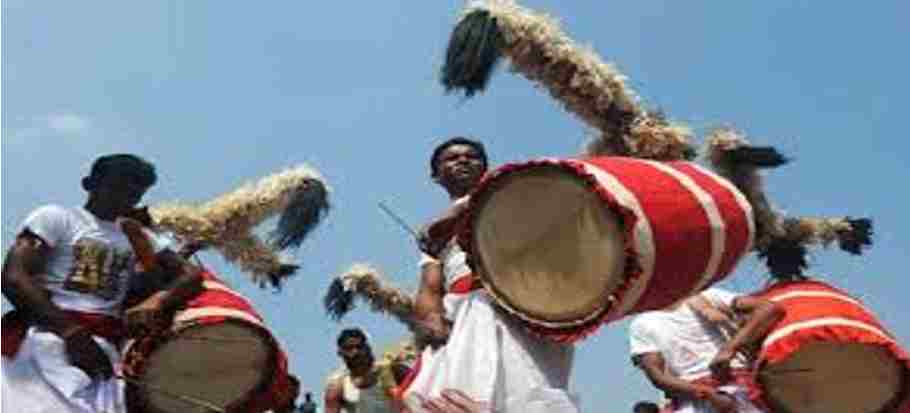
- There were mainly two kinds of embellishments or saaj that used to be made: –
Sholar Saaj- Sholar Saaj shola is used which is mainly milky white in colour and easily available in India.
- Daaker Saaj- Daaker Saaj is made from silver foil (rangta) with silver sequins which are used to be imported from Germany by mail or daak hence this is known as daaker saaj.
Panchami
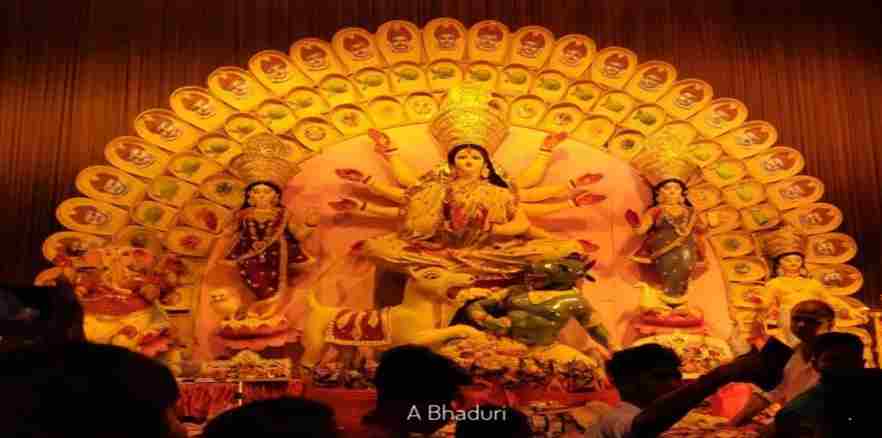
The auspicious days of puja begin from Panchami and end at Dashami, here are the rituals held on specific days which are jotted down below:
Bengali community starts with Puja celebrations from the very day of Maha Panchami. The fifth day aka Panchami holds immense significance and is commemorated with full pomp and show.
Sasti
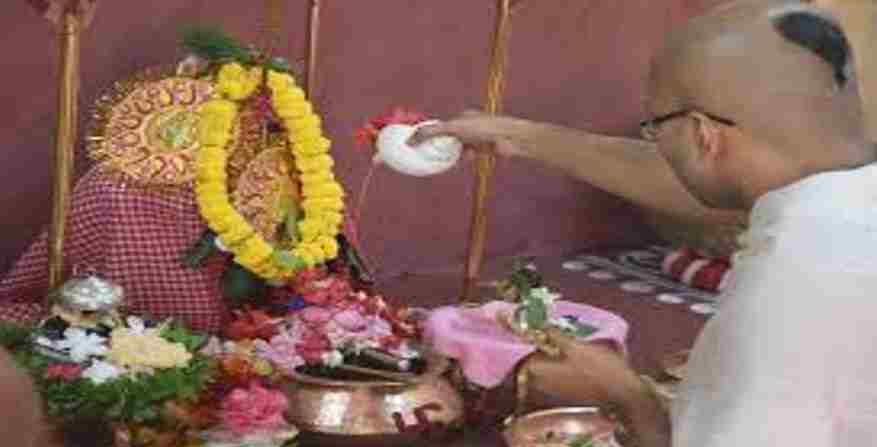
- Sasti is the sixth day of Durga Puja where the face of Devi Durga is unveiled. Here are the rituals that followed on this day;
Kalparambha: The most auspicious time to observe the Kalparambha ritual is early morning. This involves a pot or Kalash filled with water, invoking Goddess Durga in a Bilva Tree, and taking a Sankalp to perform the Durga Puja by following all the necessary customs and practices in the most religious manner for the next three days. The ritual involves the installation of a water-filled Kalash and offering worship to Goddess Durga. Sankalp is taken, which is the firm resolution to perform Pujas and rituals for the coming days.
Bodhon: It is performed at dusk; Durga puja falls midway through the sleeping period of the gods and hence they need an ‘ awakening’ which is bodhon.
Adivas: The procedure of invocation of the Devi in the Bel tree, post the bodhan, is known as adivas. Durga invocation in a Bilva tree is termed as avahana. Adivas means sanctifying the stay of the goddess in the pandal of the puja arena. She is welcomed with the beats of dhaak. Unveiling the face of the idol is the main Ritu on this day.
Amantran: Amantran means inviting the Devi to accept the puja of the next day. The Devi is then worshipped and aarti is done. This marks the ending of mahasasti. We offered prayers to accept the Navapatrika puja. Through this rite we want Devi Durga to accept the puja the next day. Devi is worshipped by five items.
Saptami
It is the seventh day of the Durga puja. Here are the rituals that followed on this day;
1. Nabapatrika/kola-bou snan: During Durga puja, all the nine holy rituals of the Navapatrika were added. It is the primitive form of Durga puja. These comprise nine plants referring to Nabapatrika and each plant refers to a significant goddess they are:
Kola gach – Devi Brahmani
Kochu gach-Devi kalika
Turmeric- Devi Durga
Jayanti- Devi kartiki
Wood apple- Devi shiva
Pomegranate- Devi raktadantika
Arum- Devi chamunda
Rice plant- Devi lakhsmi
Asoka tree- Devi sokrahita
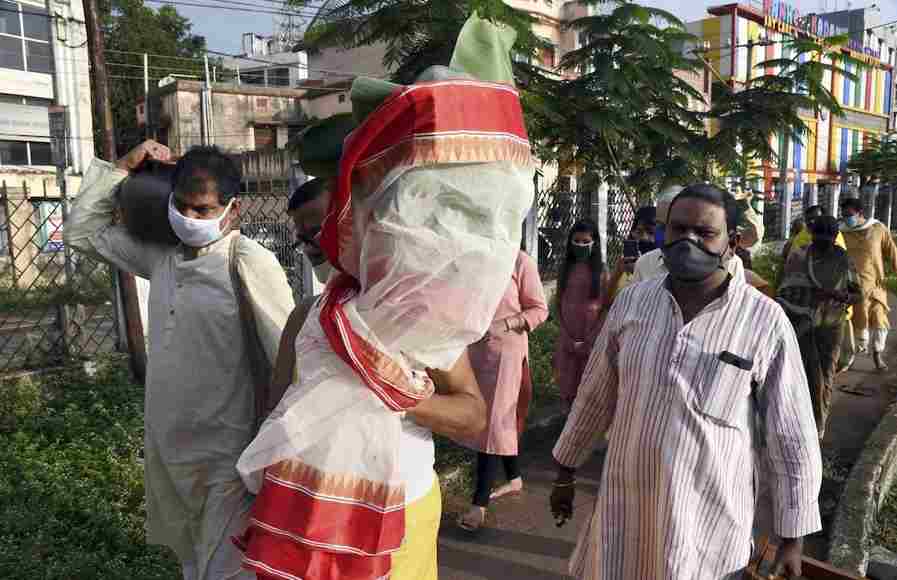
- These nine plants represent nine goddesses. These are the nine forms of Durga. In the early hours of Saptami, the twigs of the white aparajita plant along with nine bunches of yellow thread are used to tie the Navapatrika. It is then drenched in the holy water after which the Navapatrika is wrapped in a saree and placed next to Ganesha. This bathing ritual is accompanied by varied mantras and instruments for different goddesses.
2. Pran Pratishtha: Saptami is the day when the holy presence of Goddess Durga is invoked into the idols in a ritual called pran pratisthan. Sacred mantras are recited before opening the eyes of the idol it is believed that life comes into the idol of the goddess Durga after the ritual.
Astami
The eighth day of Durga Puja is known as Ashtami, and it is regarded as the most auspicious day. Here are the rituals that followed on this day;
1. Sandhi puja: During the end of the Ashtami tithi and beginning of Navami in the last 24 minutes the ritual was held so it makes “sandhikhan” when goddess Durga took the avatar of chamunda and kill the demons, Chanda, and Munda. This puja requires excellent offerings to the deity, including 108 lotus flowers, 108 lamps, sweets, a huge pot full of rice grains, a bunch of clothes, hibiscus garlands, wood apple leaves, and vermillion for the celebration.
2. Bhog: The “Bhog” distributed after Puja is taken as a blessing of Goddess Durga with equality and compassion. Bhog mainly comprises delicious Bengali dishes like khichuri, chorchori, chutney, beguni or begun bhaja, luchi, payesh, mishti doi or roshogolla. Many puja committees also offer pulao, labra, alur dom, cholar dal, aloo phulkopir dalna, chanar dalna etc.
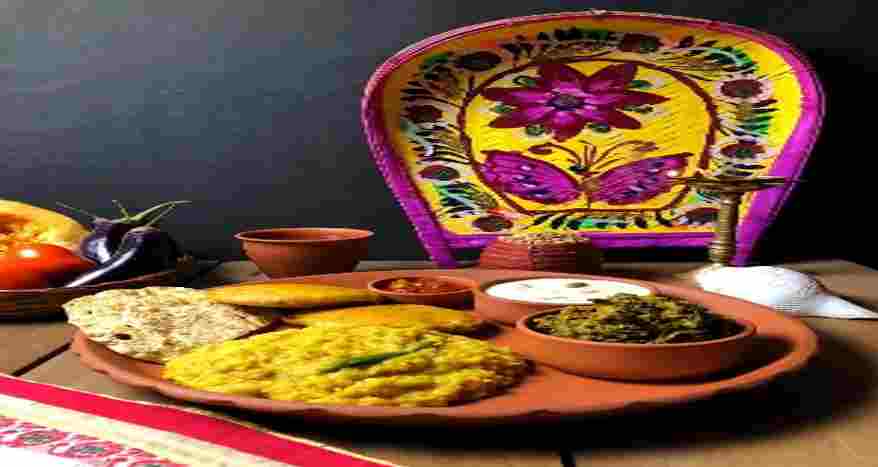
3. Kumari puja: Kumari puja refers to Kanya pujan, Bengal celebrates it in Maha Ashtami the eighth day of Durga puja, it is also known as Durga Ashtami. It refers to a ritual that involves inviting young girls and worshipping them as avatars of Devi Durga and all feast on this day. During this ritual an unmarried teenage girl is worshipped symbolically as a goddess, any girl who has not reached her puberty level is considered Kumari. Their feet are washed, dressed in new clothes, and decked up with floral ornaments and share the same stages with goddess.
Navami
- Maha Navami is the ninth day of the Durga Puja festival. Here is the ritual that followed on this day.
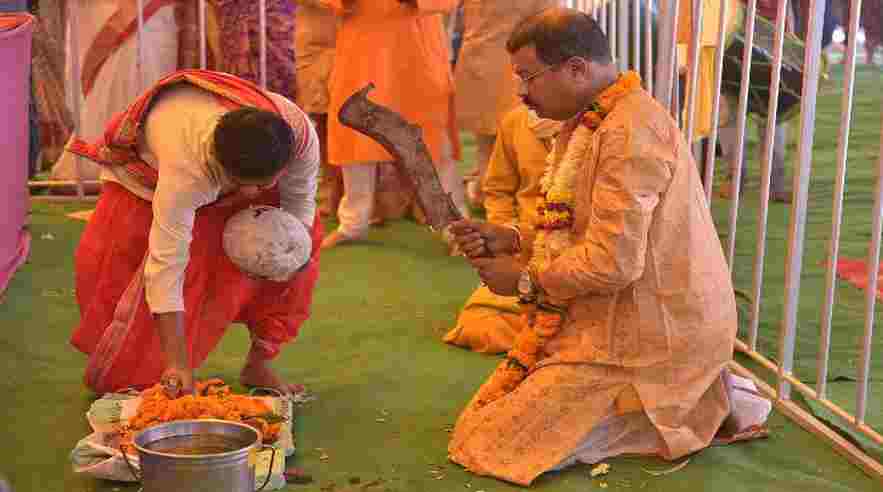
- Bolidan: Bolidan on the day of maha Navami is always performed, devotees now refrain from animal sacrifices and perform symbolic Bali with vegetables like pumpkin.
Dashami
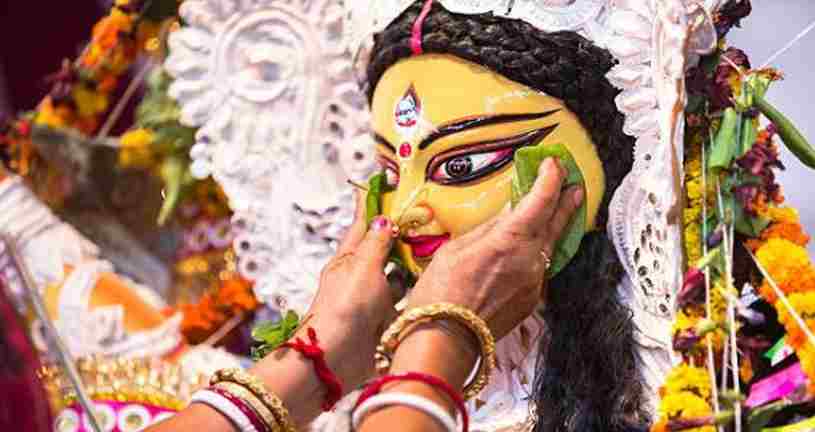
- On the tenth day of Navratri or Durgotsav, Vijaya Dashami commemorates the day that Durga appeared riding a lion to slay the Mahisasura and indicates that it is the last of Durga puja, which makes every Bengali sad, and with moist eyes, we need to on bid goodbye to our Durga Maa.
1. Sindoor Khela: During Durga puja, many rituals are performed sindoor Khela is one of them. According to Hindu scriptures, goddess Durga left her father’s house and after celebrating for a few days returns to Kailash. During the departure time, Hindu married women touched the sindoor on Devi Durga’s forehead and feet and all the married women put the sindoor on each other faces and wish each other.
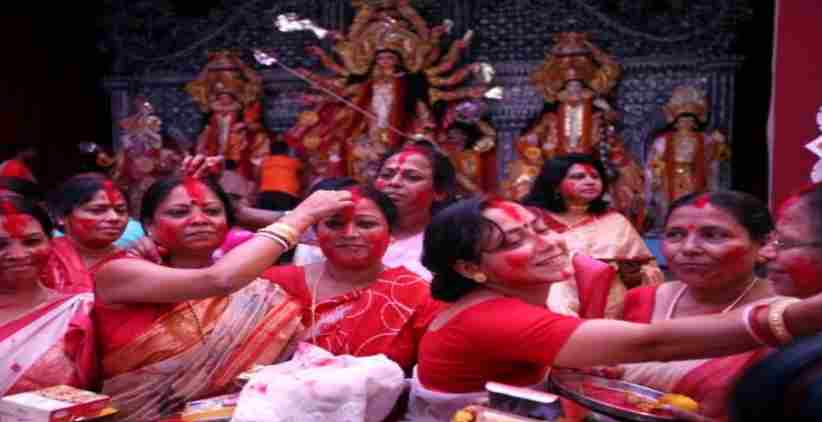
Sindoor Khela symbolizes the strength of womanhood in protecting her husband from the evil eye. They wear a white saree with a red border and accessorize it with traditional jewellery. They also put sindoor on each other shankha, conch shell, and iron bangles which are worn by married women in Bengal.
2. Bisharjon: Devotees believe that on this day, Goddess Durga goes back to Mount Kailash which is her spiritual abode. And it marks the end of the 6days puja. People worship Goddess Durga on the last day of the bisharjan and on this day Sindoor Khela is performed where married women put vermillion on each other’s foreheads and perform Durga Aarti. Women pray on this day for the longevity of their husband’s life and the happiness of their families.
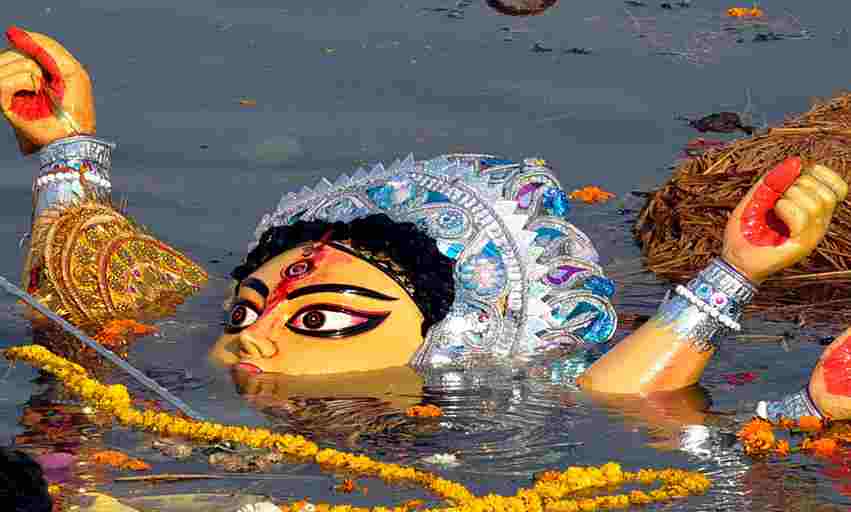
They also put vermillion on Goddess Durga’s forehead and offer her sweets as a parting tribute. This tradition is also known as Thakur Boron. After that Devi Durga and her children are immersed in the water.
Dhunuchi Nach
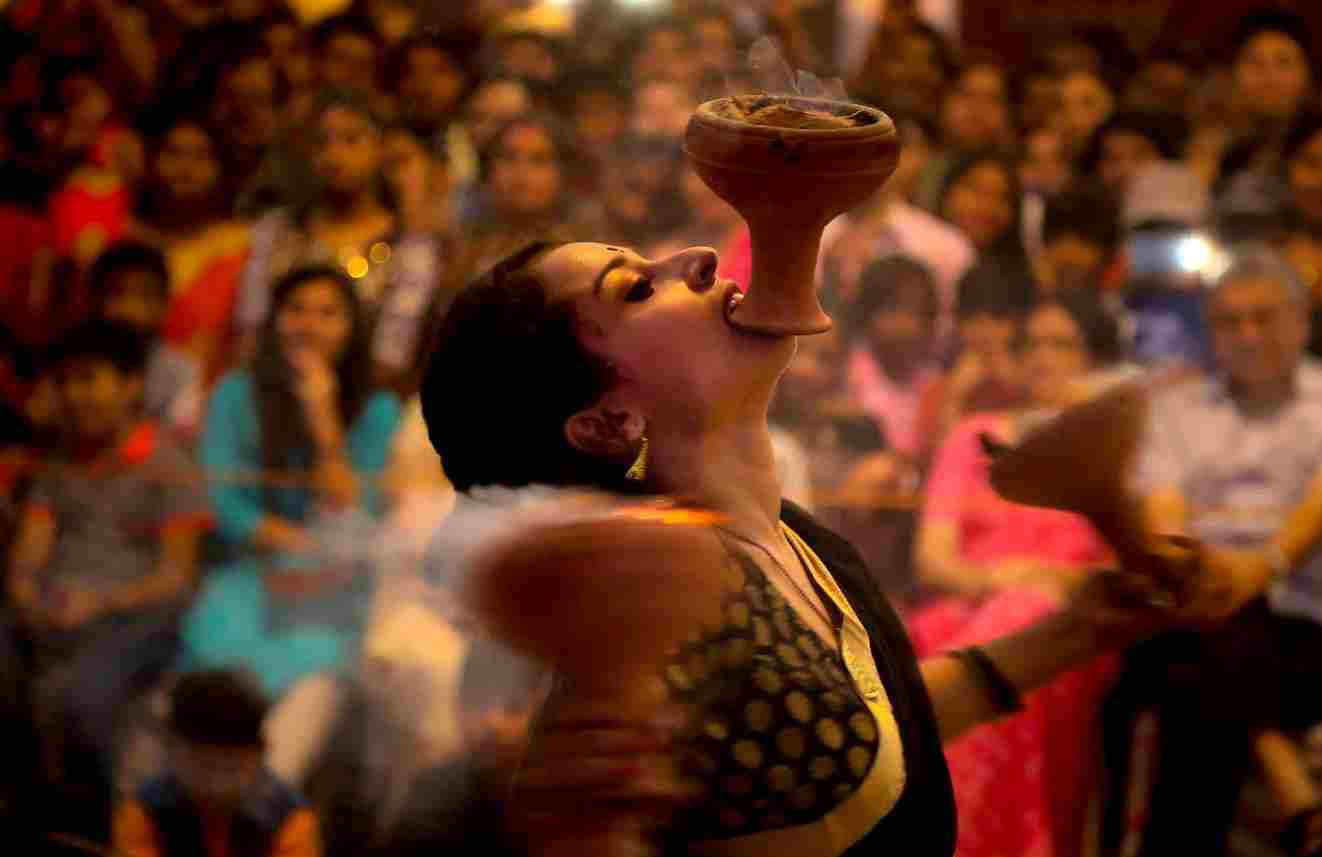
- Dhunuchi dance is an integral part of the commemoration of Durga puja. It involves dancing with a dhunuchi in their hands. A dhunuchi typically holds coconut husk and dhuno over it which produces smoke and creates a smoky effect. The Dhunuchi is extremely hot, but the devotees take it in their stride and fulfil the tradition.
Navratri And Durga Puja
Nav’ is nine and ‘Ratri’ refers to night. Thus, the festival derives its name as we celebrate it over a period of nine nights. Durga Puja is the biggest festival for Bengalis and for people living in the eastern part of India while Navratri is celebrated in the northern and western parts of India. Durga Puja, on the other, hand celebrates the victory of Goddess Durga over the demon Mahishasura. In north-eastern and eastern states, Navratri is referred to as Durga Puja. Navratri is referred to as Rama Lila or Dussehra in these regions. This symbolizes the victory of Lord Rama over the demon king Ravana, as indicated in the Ramayana. These nine days are solely dedicated to Durga and her nine avatars – the Navadurga.
The nine forms and their names are:
- Shailputri,
- Brahmachari,
- Chandraghanta,
- Kushmanda,
- Skandmata,
- Katyayani,
- Kaalratri,
- Mahagauri, and
- Siddhidatri.
- Navratri and Durga puja is celebrated to celebrate the victory of good over evil, people of India fast during Navratri and offer prayers to the nine forms of the goddess with specific rituals.
9 Goddess Dhayan Mantras
Navratri is about welcoming nine deities into our home with a healthy and pure mind and heart so that they bless our lives. The science of mantras is all about cleansing the soul and inner vibes. The chanting of mantras heals us from within and that is why they hold an important place in our Vedas and Shastras. The person who chants mantras, his mind is concentrated, and the state of meditation can be easily achieved. Chanting mantras is important not because it pleases the goddess, but because it purifies your mind and soul.
Here are nine dhayan mantras dedicated to nine different days that are important to maximize the effect of your devotion.
Navratri 1st Day: Shailputri Devi Mantra
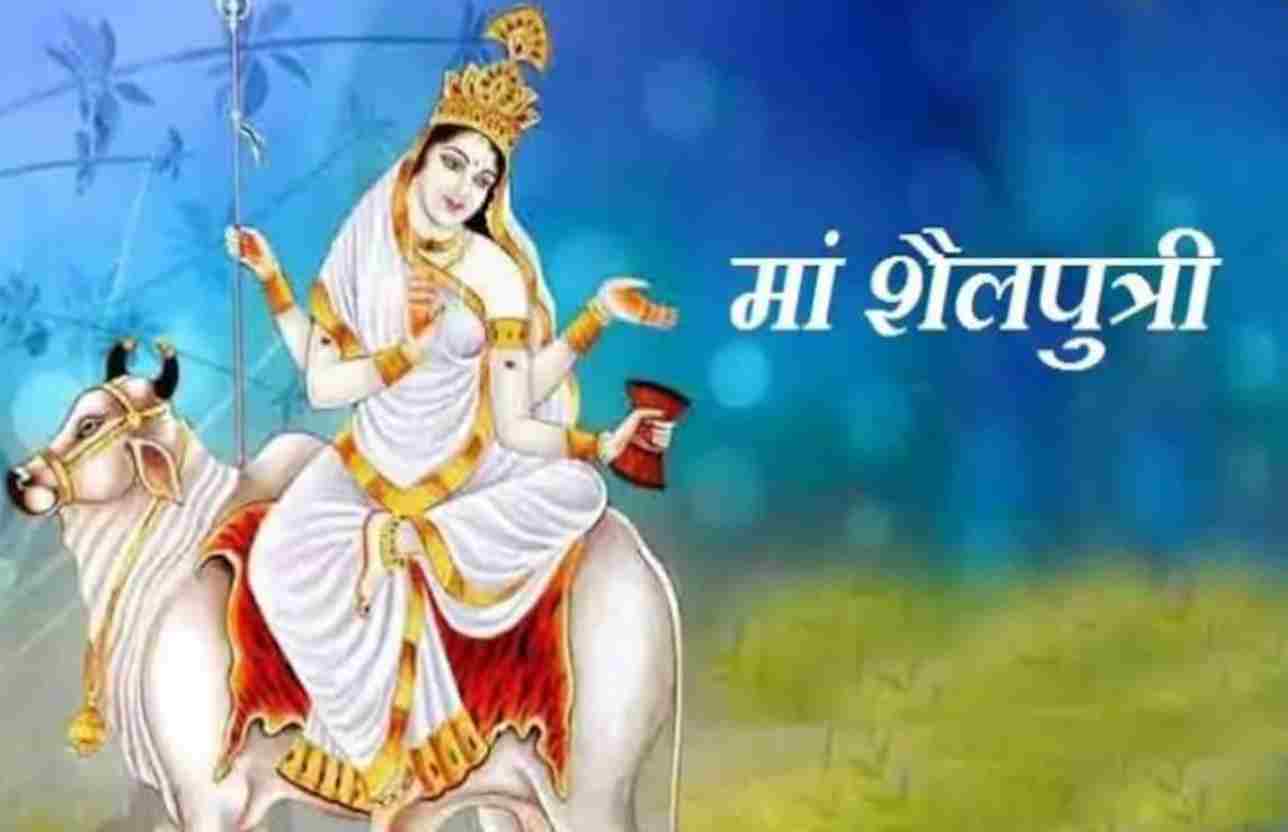
वन्दे वाञ्छितलाभाय चन्द्रार्धकृतशेखराम्। वृषारुढां शूलधरां शैलपुत्रीं यशस्विनीम्॥
Meaning: – “I offer my obeisances to the mother goddess Shaila-Putri, who bestows the best boons to the devotees. The moon in the crescent form is adorned with a crown on her forehead. She is riding a bull. She is in her hand. holds a spear. She is Yashaswini – the famous Mother Durga”.
Maa Shailputri Aarti (मां शैलपुत्री की आरती ):-
शैलपुत्री मां बैल असवार। करें देवता जय जयकार।
शिव शंकर की प्रिय भवानी। तेरी महिमा किसी ने ना जानी
पार्वती तू उमा कहलावे। जो तुझे सिमरे सो सुख पावे।
ऋद्धि–सिद्धि परवान करे तू। दया करे धनवान करे तू।
सोमवार को शिव संग प्यारी। आरती तेरी जिसने उतारी।
उसकी सगरी आस पुजा दो। सगरे दुख तकलीफ मिला दो।
घी का सुंदर दीप जला के। गोला गरी का भोग लगा के।
श्रद्धा भाव से मंत्र गाएं। प्रेम सहित फिर शीश झुकाएं।
जय गिरिराज किशोरी अंबे। शिव मुख चंद्र चकोरी अंबे।
मनोकामना पूर्ण कर दो। भक्त सदा सुख संपत्ति भर दो।
Navratri 2nd Day: Brahmacharini Devi Mantra
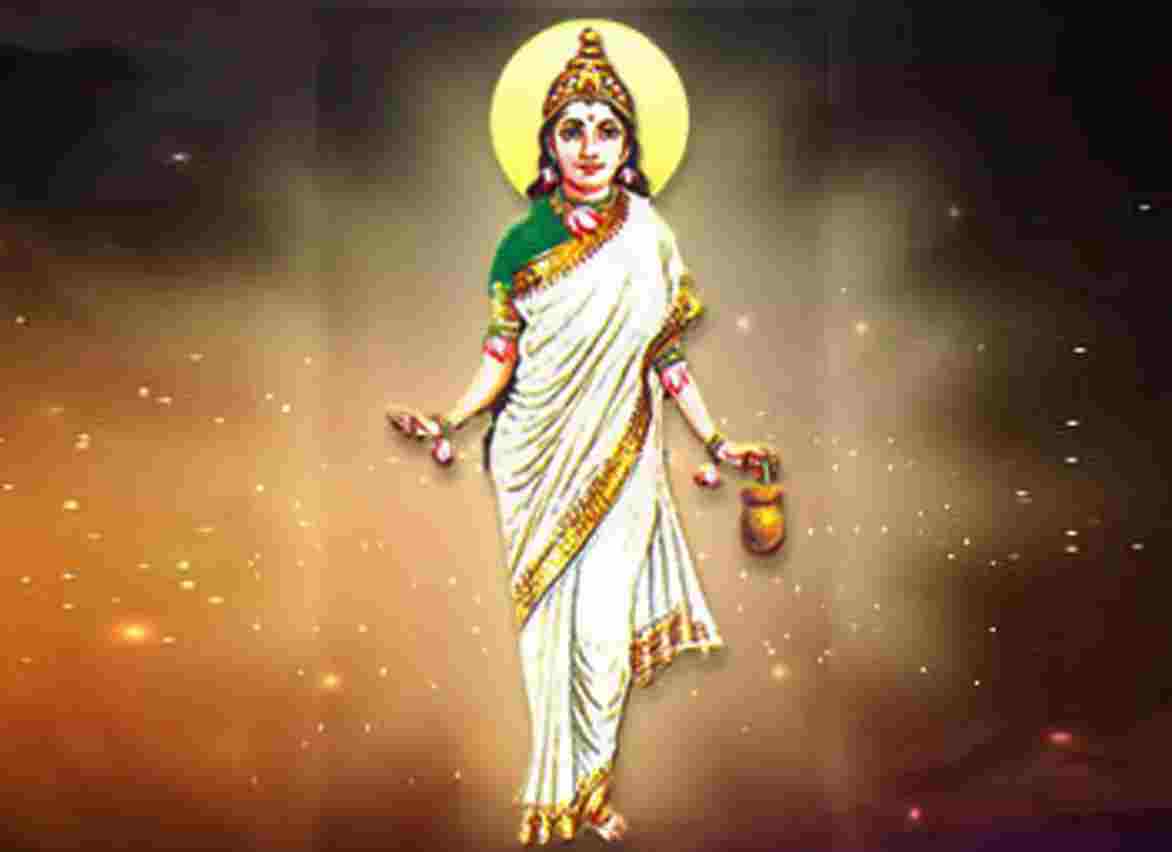
दधाना करपद्माभ्यामक्षमालाकमण्डलू। देवी प्रसीदतु मयि ब्रह्मचारिण्यनुत्तमा॥
Meaning: Oh mother! Ambe, who is everywhere and known as Brahmacharini, I bow to you time and again. Or I salute you repeatedly.
Aarti of Maa Brahmacharini ( मां ब्रह्मचारिणी की आरती):-
जय अंबे ब्रह्माचारिणी माता।
जय चतुरानन प्रिय सुख दाता।
ब्रह्मा जी के मन भाती हो।
ज्ञान सभी को सिखलाती हो।
ब्रह्मा मंत्र है जाप तुम्हारा।
जिसको जपे सकल संसारा।
जय गायत्री वेद की माता।
जो मन निस दिन तुम्हें ध्याता।
कमी कोई रहने न पाए।
कोई भी दुख सहने न पाए।
उसकी विरति रहे ठिकाने।
जो तेरी महिमा को जाने।
रुद्राक्ष की माला ले कर।
जपे जो मंत्र श्रद्धा दे कर।
आलस छोड़ करे गुणगाना।
मां तुम उसको सुख पहुंचाना।
ब्रह्माचारिणी तेरो नाम।
पूर्ण करो सब मेरे काम।
भक्त तेरे चरणों का पुजारी।
रखना लाज मेरी महतारी।
Navratri 3rd Day: Chandraghanta Devi Mantra
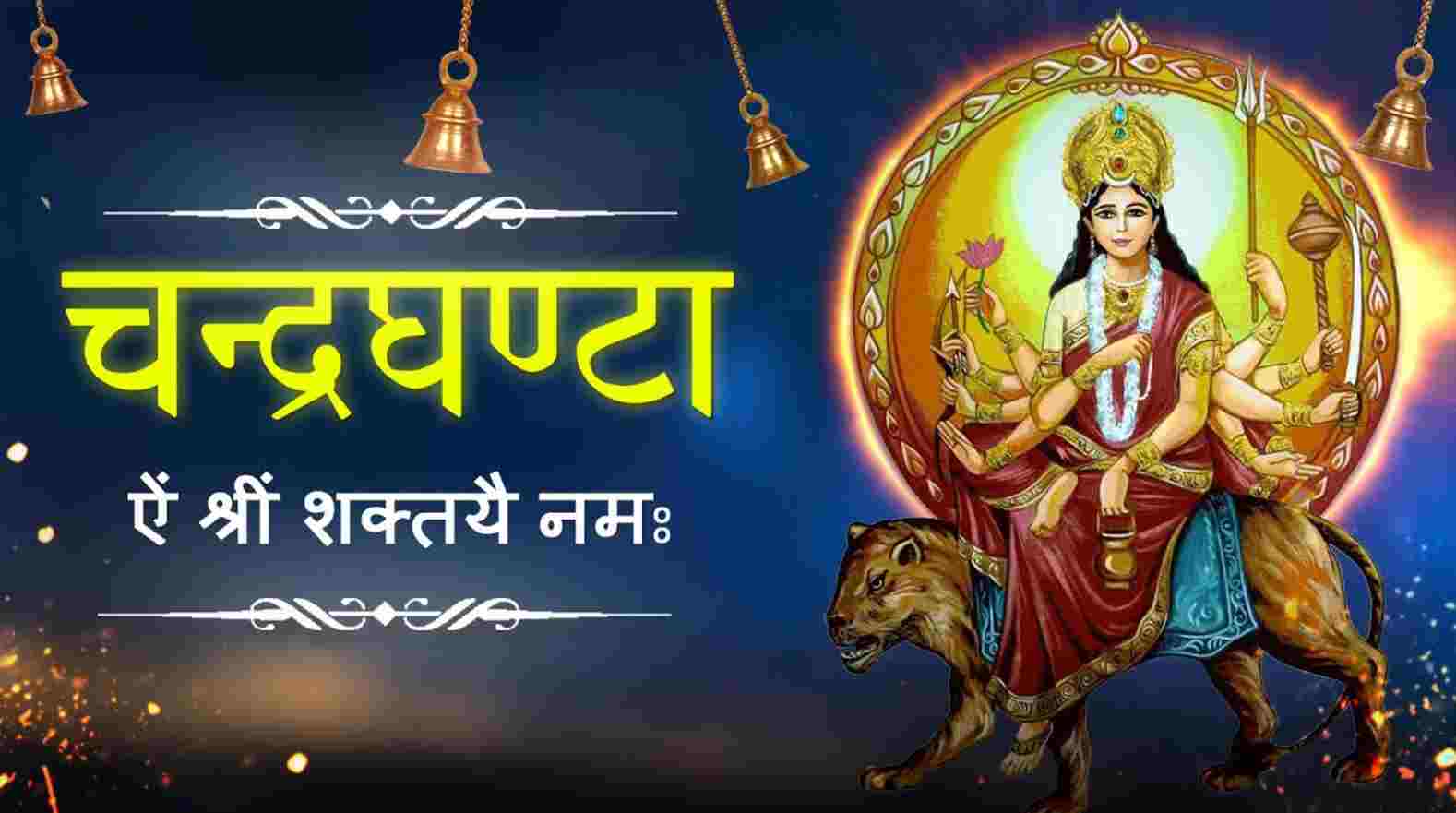
पिण्डज प्रवरारूढ़ा चण्डकोपास्त्रकैर्युता। प्रसीदम तनुते महयं चन्द्रघण्टेति विश्रुता।।
Meaning: Oh mother! Ambe everywhere and famous as Chandraghanta, salute you again and again. Or I salute you repeatedly. O Mother, deliver me from all sins.
Maa Chandraghanta Aarti (मां चंद्रघंटा की आरती ):-
जय मां चंद्रघंटा सुख धाम।
पूर्ण कीजो मेरे सभी काम।
चंद्र समान तुम शीतल दाती।चंद्र तेज किरणों में समाती।
क्रोध को शांत करने वाली
मीठे बोल सिखाने वाली।
मन की मालक मन भाती हो।
चंद्र घंटा तुम वरदाती हो।
सुंदर भाव को लाने वाली।
हर संकट मे बचाने वाली।
हर बुधवार जो तुझे ध्याये।
श्रद्धा सहित जो विनय सुनाएं।
मूर्ति चंद्र आकार बनाएं।
सन्मुख घी की ज्योति जलाएं।
शीश झुका कहे मन की बाता।
पूर्ण आस करो जगदाता।
कांचीपुर स्थान तुम्हारा।
करनाटिका में मान तुम्हारा।
नाम तेरा रटूं महारानी।
भक्त की रक्षा करो भवानी।
Navratri 4th Day: Kushmanda Devi Mantra
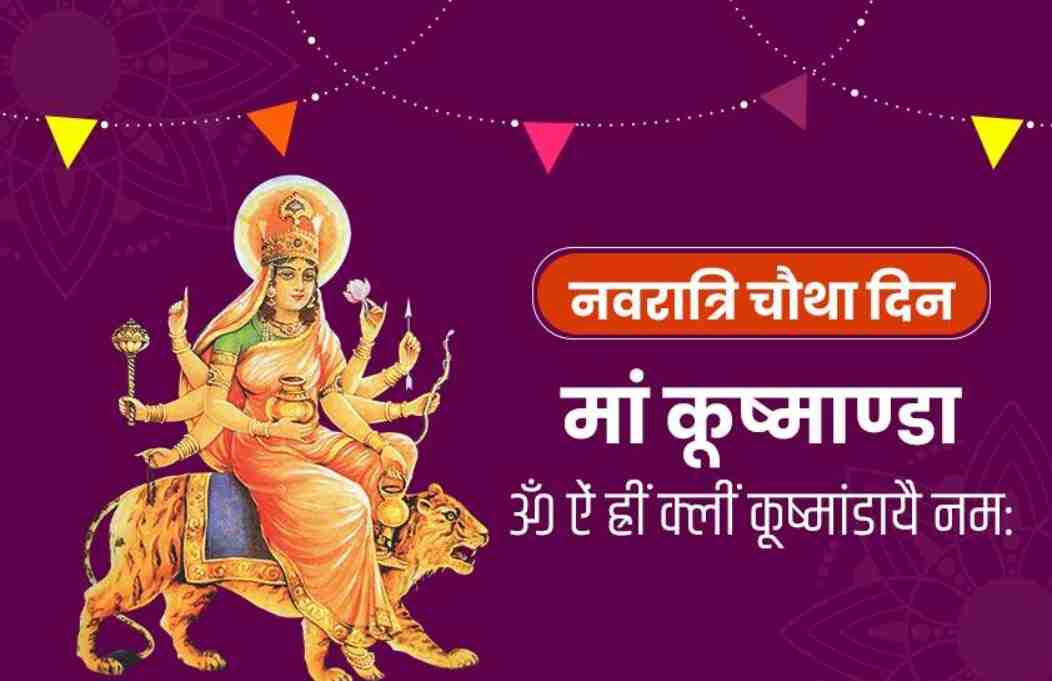
वन्दे वांछित कामार्थे चंद्रार्घ्कृत शेखराम, सिंहरुढ़ा अष्टभुजा कुष्मांडा यशस्वनिम ll
Meaning: O Mother Ambe, everywhere and popularly known as Kushmanda, I bow to you again and again. Or I salute you again and again. O Mother, grant me freedom from all sins.
Kushmanda Maa Aarti (कुष्मांडा मां आरती):-
कूष्मांडा जय जग सुखदानी।
मुझ पर दया करो महारानी॥
पिगंला ज्वालामुखी निराली।
शाकंबरी माँ भोली भाली॥
लाखों नाम निराले तेरे ।
भक्त कई मतवाले तेरे॥
भीमा पर्वत पर है डेरा।
स्वीकारो प्रणाम ये मेरा॥
सबकी सुनती हो जगदंबे।
सुख पहुँचती हो माँ अंबे॥
तेरे दर्शन का मैं प्यासा।
पूर्ण कर दो मेरी आशा॥
माँ के मन में ममता भारी।
क्यों ना सुनेगी अरज हमारी॥
तेरे दर पर किया है डेरा।
दूर करो माँ संकट मेरा॥
मेरे कारज पूरे कर दो।
मेरे तुम भंडारे भर दो॥
तेरा दास तुझे ही ध्याए।
भक्त तेरे दर शीश झुकाए॥
Navratri 5th Day: Skanda Devi Mantra
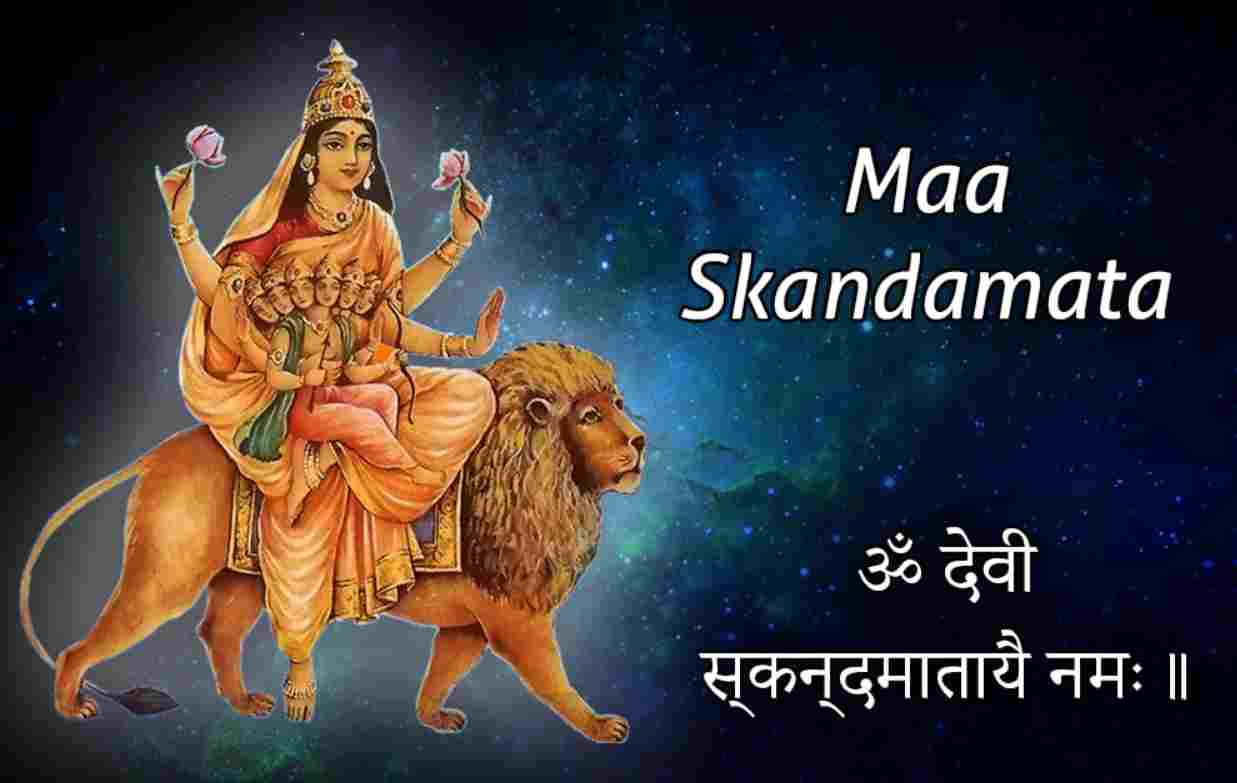
सिंहासनगता नित्यं पद्माश्रितकरद्वया. शुभदास्तु सदा देवी स्कन्दमाता यशस्विनी ll
Meaning: Oh mother! Ambe, who is everywhere and popularly known as Skandmata, I bow to you time and again. Or I salute you repeatedly. O Mother, grant me freedom from all sins. On this day the mind of the seeker is situated in the pure chakra. Lord Skandaji is seated in the form of a child in his lap.
Skanda Mata’s Aarti (स्कंद माता की आरती):-
जय तेरी हो अस्कंध माता
पांचवा नाम तुम्हारा आता
सब के मन की जानन हारी
जग जननी सब की महतारी
तेरी ज्योत जलाता रहूं मैं
हरदम तुम्हें ध्याता रहूं मैं
कई नामों से तुझे पुकारा
मुझे एक है तेरा सहारा
कही पहाड़ो पर हैं डेरा
कई शहरों में तेरा बसेरा
हर मंदिर में तेरे नजारे
गुण गाये तेरे भगत प्यारे
भगति अपनी मुझे दिला दो
शक्ति मेरी बिगड़ी बना दो
इंद्र आदी देवता मिल सारे
करे पुकार तुम्हारे द्वारे
दुष्ट दत्य जब चढ़ कर आएं
तुम ही खंडा हाथ उठाएं
दासो को सदा बचाने आई
‘चमन‘ की आस पुजाने आई ll
Navratri 6th Day: Katyayani Devi Mantra
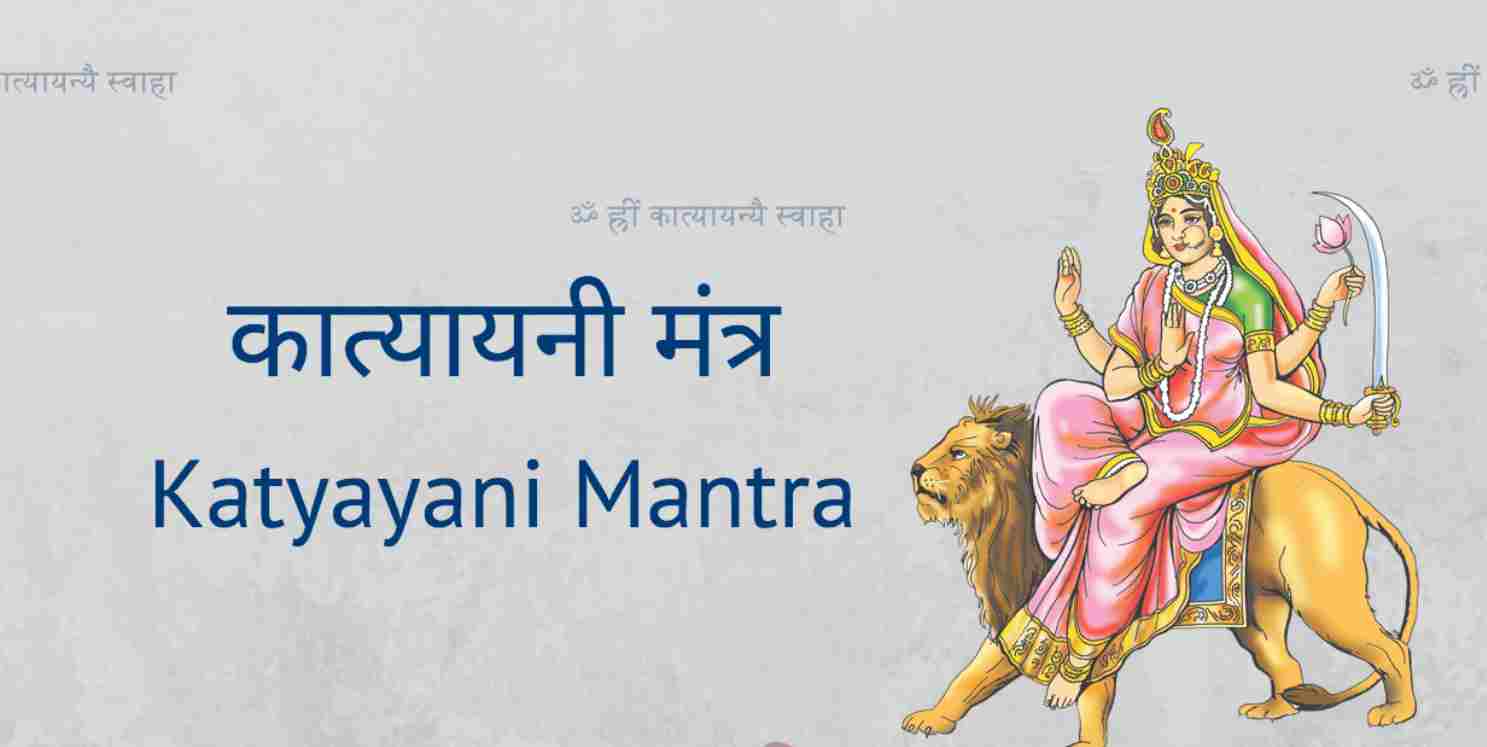
स्वर्णाआज्ञा चक्र स्थितां षष्टम दुर्गा त्रिनेत्राम्। वराभीत करां षगपदधरां कात्यायनसुतां भजामि॥
Meaning: Oh mother! I bow again and again to Ambe, who is everywhere and known as Shakti-Rupini. Or I salute you repeatedly.
Katyayani Mata Aarti (कात्यायनी माता की आरती):-
जय जय अम्बे जय कात्यानी
जय जगमाता जग की महारानी
बैजनाथ स्थान तुम्हारा
वहा वरदाती नाम पुकारा
कई नाम है कई धाम है
यह स्थान भी तो सुखधाम है
हर मंदिर में ज्योत तुम्हारी
कही योगेश्वरी महिमा न्यारी
हर जगह उत्सव होते रहते
हर मंदिर में भगत है कहते
कत्यानी रक्षक काया की
ग्रंथि काटे मोह माया की
झूठे मोह से छुडाने वाली
अपना नाम जपाने वाली
ब्रह्स्पतिवार को पूजा करिए
ध्यान कात्यानी का धरिये
हर संकट को दूर करेगी
भंडारे भरपूर करेगी
जो भी माँ को ‘चमन‘ पुकारे
कात्यानी सब कष्ट निवारे।
Navratri 7th Day: Kalratri Devi Mantra
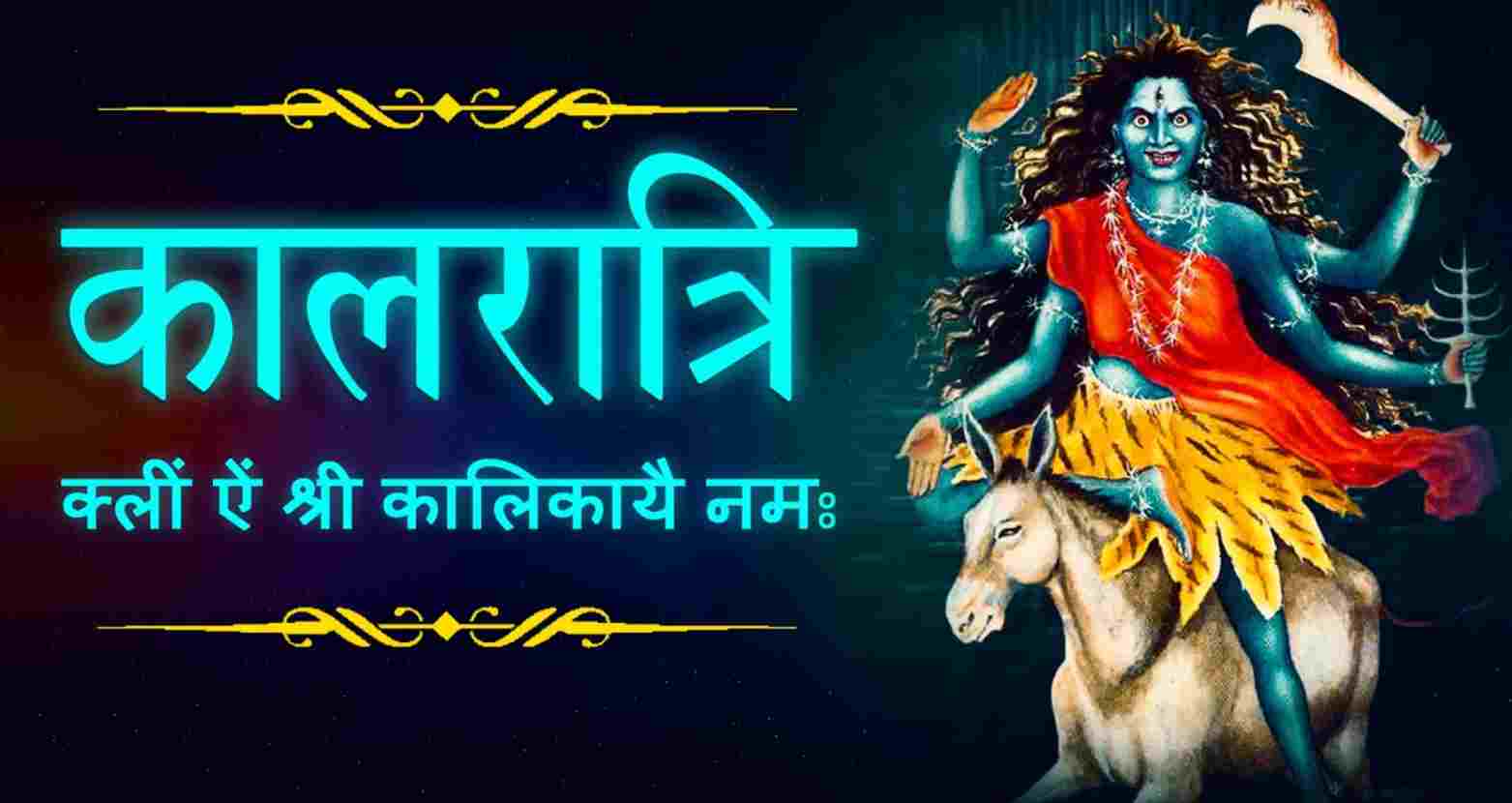
करालवंदना धोरां मुक्तकेशी चतुर्भुजाम्। कालरात्रिं करालिंका दिव्यां विद्युतमाला विभूषिताम॥
Meaning: Oh mother! Ambe, who is everywhere and known as Kalratri, I bow to you time and again. Or I salute you repeatedly. O mother, deliver me from sin.
Aarti of Maa Kalratri (मां कालरात्रि की आरती):-
कालरात्रि जय जय महाकाली
काल के मुंह से बचाने वाली
दुष्ट संहारिणी नाम तुम्हारा
महा चंडी तेरा अवतारा
पृथ्वी और आकाश पर सारा
महाकाली है तेरा पसारा
खंडा खप्पर रखने वाली
दुष्टों का लहू चखने वाली
कलकत्ता स्थान तुम्हारा
सब जगह देखूं तेरा नजारा
सभी देवता सब नर नारी
गावे स्तुति सभी तुम्हारी
रक्तदंता और अन्नपूर्णा
कृपा करे तो कोई भी दु:ख ना
ना कोई चिंता रहे ना बीमारी
ना कोई गम ना संकट भारी
उस पर कभी कष्ट ना आवे
महाकाली मां जिसे बचावे
तू भी ‘भक्त‘ प्रेम से कह
कालरात्रि मां तेरी जय ll
Navratri 8th Day: Gauri Devi Mantra
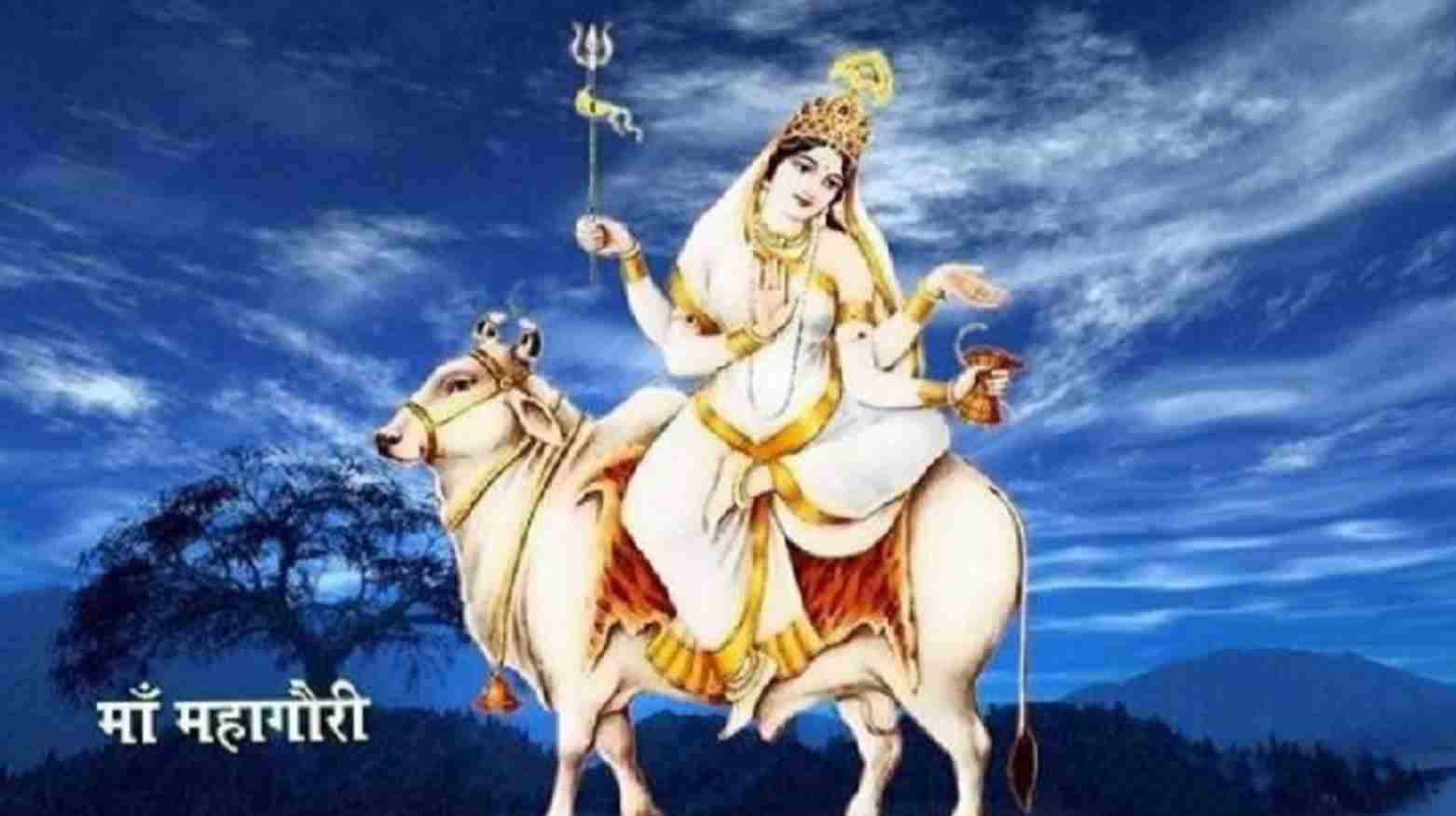
पूर्णन्दु निभां गौरी सोमचक्रस्थितां अष्टमं महागौरी त्रिनेत्राम्।
वराभीतिकरां त्रिशूल डमरूधरां महागौरी भजेम्॥
Meaning: Oh mother! Ambe, who is everywhere and popularly known as Maa Gauri, I bow to you time and again. O mother, grant me happiness and prosperity.
Maa Mahagauri Aarti (माँ महागौरी आरती )
जय महागौरी जगत की माया।
जय उमा भवानी जगत की महामाया।
हरिद्वार कनखल के पासा।
महागौरी तेरा वहां निवासा।
चंद्रकली और ममता अम्बे।
जय शक्ति जय जय मां जगदम्बे।
भीमा देवी विमला माता।
कोशकी देवी जग विख्याता।
हिमाचल के घर गौरी रूप तेरा।
महाकाली दुर्गा है स्वरूप तेरा।
सती संत हवन कुंड में था जलाया।
उसी धुएं ने रूप काली बनाया।
बना धर्म सिंह जो सवारी में आया।
तो शंकर ने त्रिशूल अपना दिखाया।
तभी मां ने महागौरी नाम पाया।
शरण आने वाले संकट मिटाया।
शनिवार की तेरी पूजा जो करता।
मां बिगड़ा हुआ काम उसका सुधरता।
भक्त बोलो तो सच तुम क्या रहे हो।
महागौरी मां तेरी हरदम ही जय हो।
Navratri 9th Day: Siddhidhatri Devi Mantra
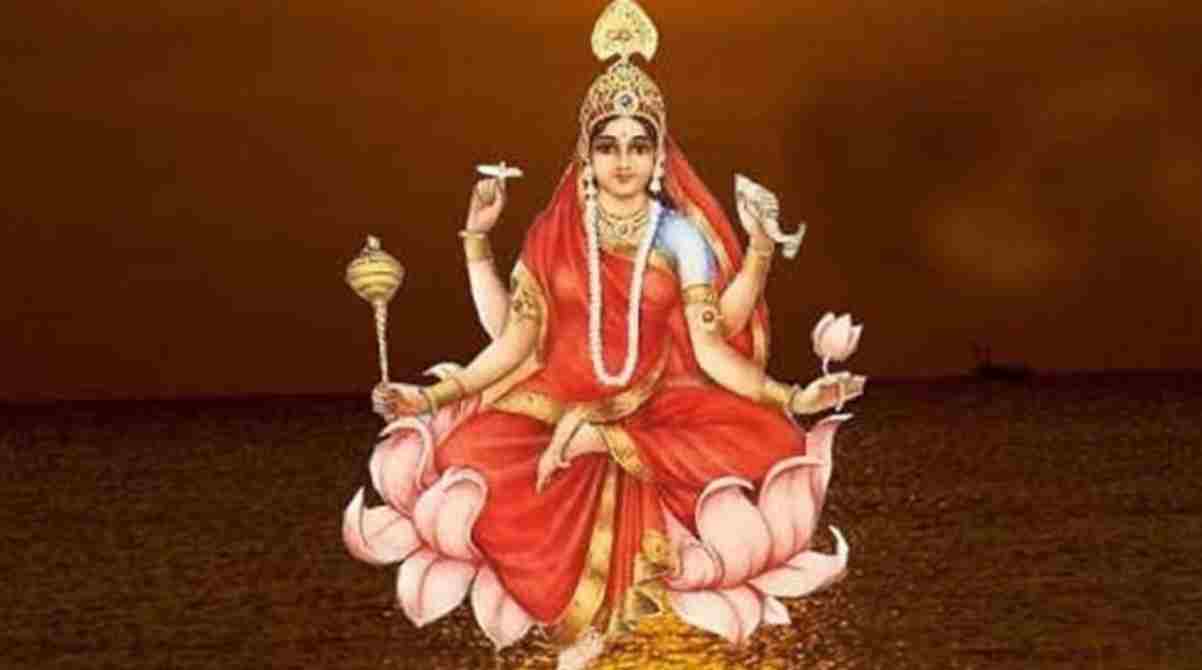
स्वर्णावर्णा निर्वाणचक्रस्थितां नवम् दुर्गा त्रिनेत्राम्।शख, चक्र, गदा, पदम, धरां सिद्धीदात्री भजेम्॥
Meaning: Oh mother! Ambe, who is everywhere and known as Mata Siddhidatri, I bow to you time and again. Or I salute you repeatedly. O mother, make me worthy of your grace.
Aarti of Maa Siddhidatri ( मां सिद्धिदात्री की आरती ):-
जय सिद्धिदात्री मां तू सिद्धि की दाता ।
तू भक्तों की रक्षक तू दासों की माता ।।
तेरा नाम लेते ही मिलती है सिद्धि ।
तेरे नाम से मन की होती है शुद्धि ।।
कठिन काम सिद्ध करती हो तुम ।
जभी हाथ सेवक के सिर धरती हो तुम ।।
तेरी पूजा में तो ना कोई विधि है ।
तू जगदंबे दाती तू सर्व सिद्धि है ।।
रविवार को तेरा सुमिरन करे जो ।
तेरी मूर्ति को ही मन में धरे जो ।।
तू सब काज उसके करती है पूरे ।
कभी काम उसके रहे ना अधूरे ।।
तुम्हारी दया और तुम्हारी यह माया ।
रखे जिसके सिर पर मैया अपनी छाया ।।
सर्व सिद्धि दाती वह है भाग्यशाली ।
जो है तेरे दर का ही अंबे सवाली ।।
हिमाचल है पर्वत जहां वास तेरा ।
महा नंदा मंदिर में है वास तेरा ।।
मुझे आसरा है तुम्हारा ही माता ।
भक्ति है सवाली तू जिसकी दाता ।।
Maa Durga Arti
Goddess Durga and her nine forms are worshiped on Navratri. It is believed that by worshiping Mother Ambe in these nine days, special fruits are obtained. To please Mother Durga in Navratri, apart from the rituals, we offer her favorite dishes, so that Mother Rani gets pleased and fulfills all our wishes. Apart from this, the aarti of Maa Durga is performed during daily worship. To get the blessings of Maa Durga during Navratri, do the aarti of Maa Durga daily.
The aarti of Maa Durga is as follows –
मां दुर्गा की आरती
जय अम्बे गौरी, मैया जय श्यामा गौरी।
तुमको निशिदिन ध्यावत, हरि ब्रह्मा शिवरी॥
जय अम्बे गौरी
माँग सिन्दूर विराजत, टीको मृगमद को।
उज्जवल से दोउ नैना, चन्द्रवदन नीको॥
जय अम्बे गौरी
कनक समान कलेवर, रक्ताम्बर राजै।
रक्तपुष्प गल माला, कण्ठन पर साजै॥
जय अम्बे गौरी
केहरि वाहन राजत, खड्ग खप्परधारी।
सुर–नर–मुनि–जन सेवत, तिनके दुखहारी॥
जय अम्बे गौरी
कानन कुण्डल शोभित, नासाग्रे मोती।
कोटिक चन्द्र दिवाकर, सम राजत ज्योति॥
जय अम्बे गौरी
शुम्भ–निशुम्भ बिदारे, महिषासुर घाती।
धूम्र विलोचन नैना, निशिदिन मदमाती॥
जय अम्बे गौरी
चण्ड–मुण्ड संहारे, शोणित बीज हरे।
मधु–कैटभ दोउ मारे, सुर भयहीन करे॥
जय अम्बे गौरी
ब्रहमाणी रुद्राणी तुम कमला रानी।
आगम–निगम–बखानी, तुम शिव पटरानी॥
जय अम्बे गौरी
चौंसठ योगिनी मंगल गावत, नृत्य करत भैरूँ।
बाजत ताल मृदंगा, अरु बाजत डमरु॥
जय अम्बे गौरी
तुम ही जग की माता, तुम ही हो भरता।
भक्तन की दु:ख हरता, सुख सम्पत्ति करता॥
जय अम्बे गौरी
भुजा चार अति शोभित, वर–मुद्रा धारी।
मनवान्छित फल पावत, सेवत नर–नारी॥
जय अम्बे गौरी
कन्चन थाल विराजत, अगर कपूर बाती।
श्रीमालकेतु में राजत, कोटि रतन ज्योति॥
जय अम्बे गौरी
श्री अम्बेजी की आरती, जो कोई नर गावै।
कहत शिवानन्द स्वामी, सुख सम्पत्ति पावै॥
जय अम्बे गौरी
Top 13 Interesting Facts About Durga Puja
1. The tradition of releasing the Neelkantha Bird on the afternoon of Dashami.
- Two birds were released. The first one was released in front of the house when the goddess made her way out of the house. The second was released when the goddess was immersed in water.
- Neelkantha, literally meaning the blue throat, represents Lord Shiva. Neelkantha birds have been stopped due to legal restrictions. Clay Neelkantha Birds were carried in a cage along with the idol of the goddess and were submerged with the idol.
2. In the year 1926, Anandabazar Patrika published its first Puja special issue, Sharadiya Sankhya.
3. The pandals are prepared for months starting from the bases to idols to the artworks.
4. The ten hands of Goddess Durga hold in them a conch, discus, lotus, sword, bow with an arrow, trishul, mace, thunderbolt, snake, and flame. Maa Durga carries these ten powerful weapons and sits on the king of all animals, the lion to go into battle against evil. Lord Vishnu’s gift symbolizes that Durga is the center of creation and that all the universes revolve around her. The lotus is the symbol of Brahma and represents wisdom, as well as liberation through knowledge. The sword represents cosmic intelligence which is symbolized by Lord Ganesh. The three-headed sharp weapon symbolizes the three Gunas of humankind i.e., tamas, rajas, and sattva. So, Goddess Durga is considered to be beyond the limits of time and hence she rules it.Given by: Lord Shiva has been his trident to Her. The sankha or conch symbolises the primordial sound ‘AUM’. Varun Dev gave her sankha. The dhanuk and teer symbolises energy where dhanuk is the symbol of potential energy and teer is the example of kinetic energy. Teer and dhanuk was given by Vayu Dev. Mace: Mace symbolises love and devotion towards Maa Durga. Mace was given by Kubera. Kharag: Kharag or axe depicts that Maa Durga holds the power to create or destroy anything. Kharag was given by Viswakarma. Vajra: Vajra symbolizes the firmness of character and supreme power. Vajra was given by Indra Dev. Snake as a weapon symbolizes consciousness and the masculine energy of Lord Shiva.
5. The season of looking longingly towards the clear blue sky of autumn and the glimpse of the white kashful can be seen during Durga Puja.
6. During the immersion on the last day the people of Bengal chant as ‘ asche bochor abar hobe’.
7. Nabapatrika was worshipped by farmers for a good harvest but as Durga puja gained popularity this ritual was inducted into the ceremony.
8. Durga Puja was declared as an Intangible Cultural Heritage of Humanity by UNESCO, in 2021.
9. The Durga Puja Carnival is an initiation by the West Bengal Government and will showcase the award-winning idols of Goddess Durga of the year’s Durga Puja Festival.
10. Swami Vivekananda, started the tradition of Kumari puja to celebrate the innocence of little girls, thus urging society to accumulate efforts to stop hate crimes against them.
11. Outside West Bengal Durga puja is equally famous as we can see in London Swiss cottage library is the oldest puja in London, supported by the London Borough of Camden.
12. The donation amount for each club organizing Durga Puja to Rs 60,000 from last year’s Rs 50,000, besides announcing a 60 percent rebate on electricity bills.
13. Kolkata is known as the “city of joy” for its festivals, and the most important one is Durga Puja which is celebrated by all people residing in Bengal.

